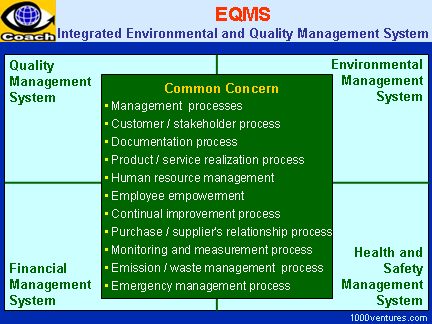
|
Common
Statement of Policy |
|
QUALITY POLICY
Top management shall define
the
→
quality
policy and ensure that it:
-
is
appropriate to the purpose of the organization,
-
includes a commitment to comply with requirements and
→
continually improve
the effectiveness of the quality management system,
-
provides a framework
for establishing and reviewing quality
objectives,
-
is
communicated and understood within the organization,
-
is
reviewed for continuing suitability
ENVIRONMENTAL POLICY
Top management shall define
environmental
policy and ensure that it:
-
is
appropriate to nature, scale & environmental impacts of
its activities, products or services,
-
includes commitment to
continual improvement and prevention of pollution,
-
includes a commitment to comply with relevant environmental
legislation and regulations and with other requirements
to which the organization subscribes,
-
provides the framework
for setting & reviewing environmental objectives and targets,
-
is
documented, implemented, maintained and
communicated to all employees,
-
is
available to public
|
→
Kaizen: 5 Principles
→
Kaizen Culture:
8 Key Elements
→
Implementing Kaizen:
7 Conditions
→
Lean Enterprise:
Kore 10 Tips
 Example of a
Truly Lean Value Chain
Example of a
Truly Lean Value Chain
|
Achieving Synergy
A market study in the
Netherlands initiated by The Dutch Technical Committee on Quality Management
and carried out by the Netherlands Standardization Institute (NEN) in
collaboration with Tilburg University TIAS Business School concluded that
full integration between ISO 9001:2000 and ISO 14001 was possible and
it was easiest for organizations that had structured their ISO 9001
Quality Management System together with their
business processes and such integration could lead to valuable
→
synergies.
The
First Step: Initial appraisal
At the point of
implementation of the management system especially for first time it is
better to know where the organization stands with reference to the
requirements it is going to conform to. Both the management system standards
provide guidelines to establish this fact
– one
through Initial Environmental Review and another through Self Assessment.
This exercise is voluntary
in both the management systems. But it is very important to set the
goals for
→
continuous improvement
in motion based on facts.
Common
Statement of Policy
Policy is overall intentions and
direction of organization related to quality/environment as formally
expressed by the top management. Both management systems have enunciated
norms for defining the policy. Keeping those guideline in mind a single
policy may be developed. The requirements of both standards are now
similar.
Common Management
Representative
Management representative is a
necessary position laid down in the standards with very clear responsibility
and authority. In a normal situation organizations implementing these
systems appoint two MR’s – one for quality and another for environment.
Since it is coordination position in the organization, it should be
preferable to appoint one MR for both the systems. If work is of high
magnitude depending on the size and complexity of the organization, he may
be assisted by one person from quality and another from environment.
Common
Statement of Objectives
Both management systems demand
establishment of objectives – one directed towards quality and another for
environment. Both specify that they be “established at relevant functions
and levels within the organization”. There is possibility that same
personnel for quality may be assigned to look after both environment and
quality objectives especially in
SMEs.
Deming's 14 Point's Plan for
→
TQM
Point 1:
Create constancy of purpose toward improvement of the product
and service so as to
become competitive, stay in business and provide jobs...
More
→
Radical Improvement:
Kore 10 Tips
 Canon Canon
Canon is famous for its
environmentally-conscious manufacturing and logistics. The
Canon Production System
(CPS) includes:
According to Canon Production System,
9 wastes are to be eliminated:
|